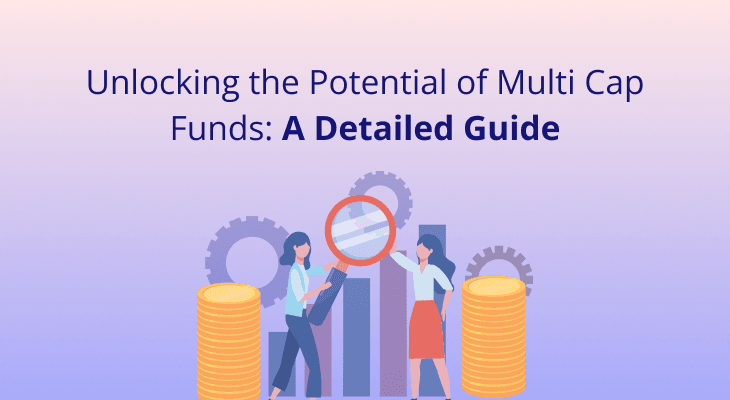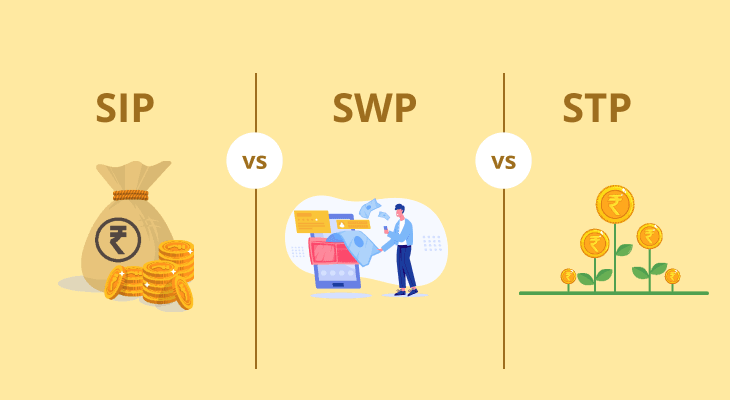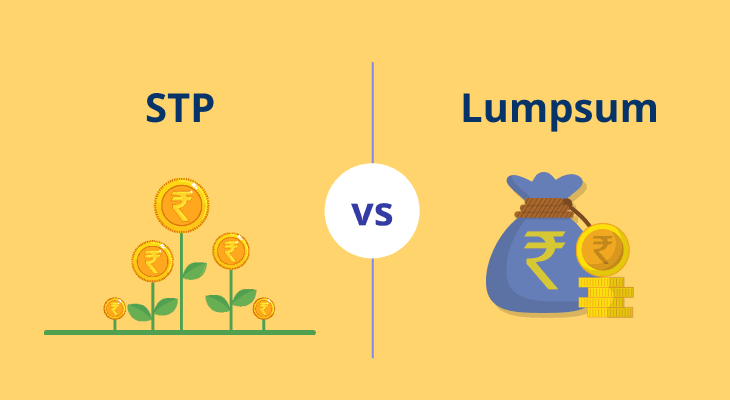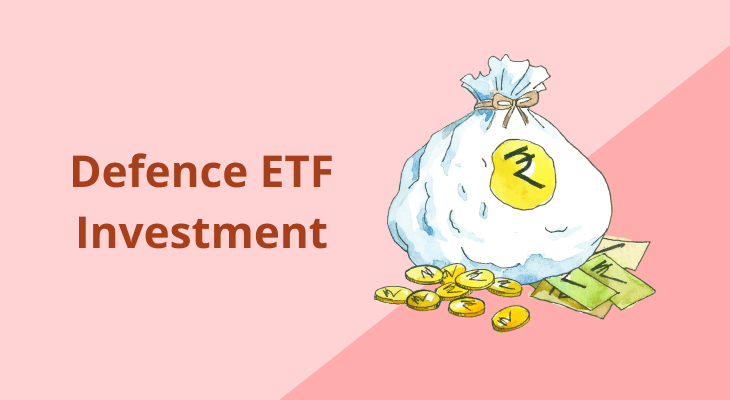
Unlocking the Potential of Multi Cap Funds: A Detailed Guide
Let us use a metaphor to understand the concept of Multi Cap Funds. Think of yourself as a chef creating a delicious pizza. Large cap stocks are like the sturdy pizza base that form the crust and provide a reliable foundation. Now, consider mid cap stocks as the flavorful toppings and assume small cap stocks are the delightful seasoning. Together, these bring a mix of exciting tastes and complete your flavourful pizza. This pizza summarises what a multi cap fund is made of. The beauty of Multi Cap Funds lies in the flexibility to adjust the recipe. Want more stability? Add more large caps. Craving some excitement? Sprinkle in mid and small caps. You can cook it the way your taste buds like it.
Multi Cap Funds represent a dynamic category within the mutual fund landscape, offering you exposure to a diversified portfolio spanning across various market capitalisations. These funds don't restrict themselves to a specific market segment and can invest in large cap, mid cap, and small cap stocks, providing flexibility and customisation in capital allocation.
Now that you understand the meaning of multi cap funds, let us explore their key purpose, components, features, and benefits.
Purpose and Objectives
Multi Cap Funds aim to achieve long-term capital appreciation by investing in a diversified portfolio. The primary objectives include:
Capital Growth
Multi Cap Funds target capital growth by identifying opportunities across the entire market spectrum. The flexibility in choosing stocks allows them to capture potential returns in various market segments.
Risk Mitigation
Diversification across market caps helps in spreading risk. While large-cap stocks provide stability, mid and small-cap stocks bring growth potential. This balanced approach seeks to mitigate the impact of volatility.
Key Components of Multi Cap Funds
Diverse Portfolio Composition
Multi Cap Funds have the freedom to invest across market caps, enabling fund managers to navigate market conditions strategically. The allocation varies based on prevailing market trends and the fund manager's outlook.
Adaptability To Market Dynamics
These funds can dynamically adjust their portfolio in response to changing market conditions. During different phases of the market cycle, fund managers may tilt the allocation towards large, mid, or small-cap stocks.
Features of Multi Cap Funds
Portfolio Composition
The fund's portfolio comprises a mix of large-cap, mid-cap, and small-cap stocks, allowing for a diversified investment strategy.
Active Management
Fund managers actively monitor and adjust the portfolio to optimise returns based on market trends and economic conditions.
Risk-Return Profile
The fund's risk-return profile depends on the allocation across market caps. The mix aims to strike a balance between stability and growth.
Investment Horizon
Multi Cap Funds are suitable for investors with a moderate to long-term investment horizon, as the fund's performance may unfold over time.
Benefits of Multi Cap Funds
Diversification
Multi Cap Funds offer a one-stop solution for diversification, spreading your investment across large, mid, and small-cap stocks. This diversification helps mitigate the impact of poor-performing assets.
Growth Potential
The inclusion of mid and small-cap stocks provides these funds with the potential for higher growth compared to large-cap-focused funds. This can be appealing to investors seeking capital appreciation over the long term.
Flexibility
Multi Cap Funds provide fund managers with the flexibility to adjust their portfolios based on market conditions. This adaptability allows them to capitalise on opportunities and navigate challenges effectively.
Risk-Adjusted Returns
While mid and small-cap stocks introduce some level of risk, the presence of large-cap stocks provides stability. This balanced approach aims to balance risk and return, making Multi Cap Funds suitable for investors with varying risk tolerances.
Market Opportunities
Multi Cap Funds can tap into opportunities across the market, capturing growth potential in both established and emerging companies.
Risks Associated with Multi Cap Funds
Market Volatility
The inclusion of mid and small-cap stocks exposes Multi Cap Funds to higher market volatility compared to large-cap funds. This volatility can lead to fluctuations in the fund's NAV.
Managerial Decisions
Successful implementation of the Multi Cap strategy relies on the fund manager's ability to make effective allocation decisions across different market segments. Managerial expertise is crucial for optimising returns.
Key Factors to Consider
There are a large number of multi cap funds offered by several fund houses. So, which one is right for you? This decision can be complex. To find the ideal fund scheme for your needs, here are a few factors that you should consider.
Investment Horizon
Multi Cap Funds are well-suited for long-term investors willing to ride out market fluctuations for potential higher returns.
Risk Tolerance
Assess your risk tolerance, as the fund's exposure to different market caps can influence its volatility.
Expense Ratio
Keep an eye on the expense ratio, as lower costs can contribute to better overall returns. A higher expense ratio is likely to eat into your eventual profits.
Performance Metrics
Evaluate historical performance metrics such as Compound Annual Growth Rate (CAGR), Standard Deviation, and Sharpe Ratio. These metrics provide insights into the fund's historical risk-adjusted performance.
Always compare among the various options before making your decision. If you’re new to investing, you can consult your financial advisor to help you out.
Conclusion
Multi Cap Funds offer investors a versatile investment avenue, combining the benefits of diversification, flexibility, and potential for capital appreciation. Understanding their features, risks, and alignment with individual investment goals is crucial for making informed investment decisions. As with any investment, thorough research and consideration of personal financial objectives are key to optimising the benefits of Multi Cap Funds.
SIPs let you invest small amounts regularly, making it easier to stay consistent with your goals. With time, your money grows faster through compounding, helping you get the most out of your investments. Try our SIP Calculator to see how your money can grow and make smarter plans for your future.
FAQ
What is a Multi Cap Fund?
Multi Cap Funds are mutual funds that invest in a mix of large, mid, and small-cap stocks, offering investors a diversified and adaptable investment strategy.
How do Multi Cap Funds Work?
These funds work by dynamically allocating investments across different market segments based on prevailing economic conditions and market trends.
Who Should Invest in Multi Cap Funds?
Multi Cap Funds are suitable for investors seeking a balanced mix of stability and growth, making them an ideal choice for those with moderate risk tolerance.
What Risks are Associated with Multi Cap Funds?
While these funds offer diversification benefits, they can be influenced by market volatility, especially when exposed to mid and small-cap stocks.
Can Multi Cap Funds be Considered for Long-term Goals?
Yes, these funds can be considered for long-term goals as they aim to provide capital appreciation over a moderate to extended investment horizon.
How Are Multi Cap Funds Managed?
Fund managers actively monitor market conditions and strategically adjust the fund's portfolio to optimise returns across different market caps.
What is the main difference between Multi Cap Funds and Flexi Cap Funds?
Typically, a multi cap fund needs to allot 25% of its holding to large cap, mid cap, and small cap companies, each. A flexi cap fund is more dynamic in nature and does not have this restriction.
What Metrics Should I Consider Before Investing?
Investors should assess metrics like Compound Annual Growth Rate (CAGR), Sharpe Ratio, Standard Deviation, Alpha, and Beta to understand the fund's historical performance and risk-adjusted returns.
How Can Multi Cap Funds Benefit Dynamic Asset Allocators?
For investors adopting a dynamic asset allocation strategy, Multi Cap Funds offer the flexibility to adapt to changing market conditions and adjust the portfolio accordingly.


